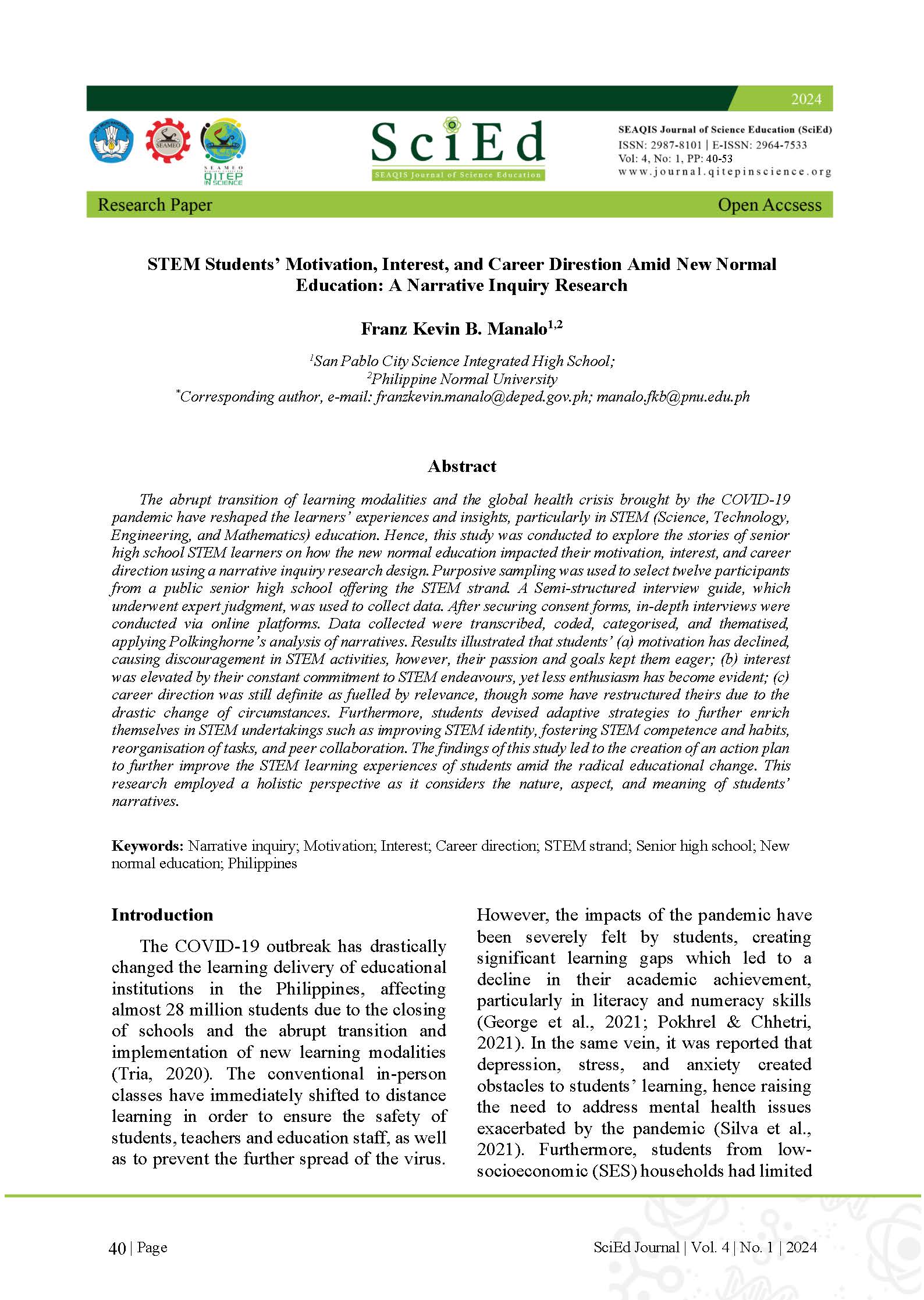STEM Students’ Motivation, Interest, and Career Direction Amid New Normal Education: A Narrative Inquiry Research
DOI:
https://doi.org/10.58249/sjse.v4i1.132Keywords:
Narrative inquiry, motivation, interest, career direction, STEM strandAbstract
The abrupt transition of learning modalities and the global health crisis brought by the COVID-19 pandemic have reshaped the learners’ experiences and insights, particularly in STEM (Science, Technology, Engineering, and Mathematics) education. Hence, this study was conducted to explore the stories of senior high school STEM learners on how the new normal education impacted their motivation, interest, and career direction using a narrative inquiry research design. Purposive sampling was used to select twelve participants from a public senior high school offering the STEM strand. A Semi-structured interview guide, which underwent expert judgment, was used to collect data. After securing consent forms, in-depth interviews were conducted via online platforms. Data collected were transcribed, coded, categorised, and thematised, applying Polkinghorne’s analysis of narratives. Results illustrated that students’ (a) motivation has declined, causing discouragement in STEM activities, however, their passion and goals kept them eager; (b) interest was elevated by their constant commitment to STEM endeavours, yet less enthusiasm has become evident; (c) career direction was still definite as fuelled by relevance, though some have restructured theirs due to the drastic change of circumstances. Furthermore, students devised adaptive strategies to further enrich themselves in STEM undertakings such as improving STEM identity, fostering STEM competence and habits, reorganisation of tasks, and peer collaboration. The findings of this study led to the creation of an action plan to further improve the STEM learning experiences of students amid the radical educational change. This research employed a holistic perspective as it considers the nature, aspect, and meaning of students’ narratives.
References
Albalate, A. R., Larcia, H. D. S., Jaen, J. A. R., Pangan, K. R. O., & Garing, A. G. (2018). Students’ motivation towards science learning (SMTSL) of STEM students of University of Batangas, Lipa City. People: International Journal of Social Sciences, 3(3), 1262–1274. https://doi.org/10.20319/pijss.2018.33.1262127
Aque, A., Barquilla, M., Buan, A., & Bagaloyos, J. (2021). Asynchronous learning: Its effects on academic performance and students’ motivation in science. Thabiea: Journal Of Natural Science Teaching, 4(1), 17. https://doi.org/10.21043/thabiea.v4i1.9806
Baltà-Salvador, R., Olmedo-Torre, N., Peña, M., & Renta-Davids, A. I. (2021). Academic and emotional effects of online learning during the COVID-19 pandemic on engineering students. Education and Information Technologies, 26(6), 7407–7434. https://doi.org/10.1007/s10639-021-10593-1
Bolds, T. (2017). A structural and intersectional analysis of high school students’ STEM career development using a social cognitive career theory framework (Published Dissertation). Syracuse University, Syracuse, New York.
Byrnes, Y. M., Civantos, A. M., Go, B. C., McWilliams, T. L., & Rajasekaran, K. (2020). Effect of the COVID-19 pandemic on medical student career perceptions: a national survey study. Medical Education Online, 25(1), 1798088. https://doi.org/10.1080/10872981.2020.1798088
Capone, R., & Lepore, M. (2021). From Distance Learning to Integrated Digital Learning: A Fuzzy Cognitive Analysis Focused on Engagement, Motivation, and Participation During COVID-19 Pandemic. Technology, Knowledge and Learning. https://doi.org/10.1007/s10758-021-09571-w
Desrochers, M., Naybor, D., & Kelting, D. (2020). Perceived impact of COVID-19 and other factors on STEM students’ career development. Journal of Research in STEM Education, 6(2), 138–157. https://doi.org/10.51355/jstem.2020.91
Etikan, I. (2016). Comparison of convenience sampling and purposive sampling. American Journal of Theoretical and Applied Statistics, 5(1), 1. https://doi.org/10.11648/j.ajtas.20160501.11
Forakis, J., March, J. L., & Erdmann, M. (2020). The impact of COVID-19 on the academic plans and career intentions of future STEM professionals. Journal of Chemical Education, 97(9), 3336–3340. https://doi.org/10.1021/acs.jchemed.0c00646
Francis, M. K., Wormington, S. V., & Hulleman, C. (2019). The costs of online learning: Examining differences in motivation and academic outcomes in online and face-to-face community college developmental mathematics courses. Frontiers in Psychology, 10. https://doi.org/10.3389/fpsyg.2019.02054
Fuller, M., Holzweiss, P. & Joyner, S. (2015). The importance of peer connections in distance education. International Journal of Instructional Technology and Distance Learning, 12(2), 1-58.
George, G., Dilworth-Bart, J., & Herringa, R. (2021). Potential socioeconomic effects of the COVID-19 pandemic on neural development, mental health, and K-12 educational achievement. Policy Insights from the Behavioral and Brain Sciences, 8(2), 111–118. https://doi.org/10.1177/23727322211032248
Hariri, H., Karwan, D.H., Haenilah, E.Y., Rini, R., & Suparman. U. (2021). Motivation and learning strategies: student motivation affects student learning strategies. European J Ed Res.10(1), 39-49. https://doi.org/10.12973/eu-jer.10.1.39
Hickson, H. (2015). Becoming a critical narrativist: Using critical reflection and narrative inquiry as research methodology. Qualitative Social Work, 15(3), 380-391
Kelley, T.R., & Knowles, J.G. (2016). A conceptual framework for integrated STEM education. International Journal of STEM Education, 3(11), 1-11. https://doi.org/10.1186/s40594-016-0046-z
Marzoli, I., Colantonio, A., Fazio, C., Giliberti, M., Scotti Di Uccio, U., & Testa, I. (2021). Effects of emergency remote instruction during the COVID-19 pandemic on university physics students in Italy. Physical Review Physics Education Research, 17(2). https://doi.org/10.1103/physrevphyseducres.17.020130
McGunagle, D., & Zizka, L. (2020). Employability skills for 21st-century STEM students: the employers’ perspective. Higher Education, Skills and Work-Based Learning, 10(3), 591–606. https://doi.org/10.1108/heswbl-10-2019-0148
Minichiello, A., Lawanto, O., Goodridge, W., Iqbal, A., & Asghar, M. (2022). Flipping the digital switch: Affective responses of STEM undergraduates to emergency remote teaching during the COVID-19 pandemic. Project Leadership and Society, 3, 100043. https://doi.org/10.1016/j.plas.2022.100043
NEDA. (2017). Philippine Development Plan 2017-2022. https://pdp.neda.gov.ph/updated-pdp-2017-2022
Ntinda, K. (2019). Narrative research. Handbook of Research Methods in Health Social Sciences, 411–423. https://doi.org/10.1007/978-981-10-5251-4_79
Paechter, M., & Maier, B. (2010). Online or face-to-face? Students’ experiences and preferences in e-learning. The Internet and Higher Education, 13(4), 292–297. https://doi.org/10.1016/j.iheduc.2010.09.004
Pinar, F. I. (2021). Grade 12 students’ perceptions of distance learning in general chemistry subject: Evidence from the Philippines. International Journal of Theory and Application in Elementary and Secondary School Education, 3(1), 44–61. https://doi.org/10.31098/ijtaese.v3i1.509
Point, K. (2022). COVID-19 Learning gap: Opportunities for educational reinvention. https://www.aypf.org/blog/covid-19-learning-gap-opportunities-for-educational-re-invention/
Pokhrel, S., & Chhetri, R. (2021). A literature review on impact of the COVID-19 pandemic on teaching and learning. Higher Education for the Future, 8(1), 133–141. https://doi.org/10.1177/2347631120983481
Polkinghorne, DE. (1995). Narrative configuration in qualitative analysis. International Journal of Qualitative Studies in Education, 8(1), pp. 5-23
Rafanan, R. J., de Guzman, C. Y., & Rogayan, D. J. (2020). Pursuing STEM careers: Perspectives of senior high school students. Participatory Educational Research, 7(3), 38–58. https://doi.org/10.17275/per.20.34.7.3
Santos, L. M. D. (2020). The Relationship between the COVID-19 Pandemic and Nursing Students’ Sense of Belonging: The Experiences and Nursing Education Management of Pre-Service Nursing Professionals. International Journal of Environmental Research and Public Health, 17(16), 5848. https://doi.org/10.3390/ijerph17165848
Sarac, H. (2018). The effect of science, technology, engineering, and mathematics-STEM educational practices on students’ learning outcomes: a meta-analysis study. The Turkish Journal of Educational Technology, 17(2), 125-142. https://doi.org/10.29333/iejme/5885
Seidman, I. (1998). Interviewing as qualitative research: A guide for researchers in education and the social sciences. New York: Teachers College Press
Selco, J. I., & Habbak, M. (2021). STEM Students’ Perceptions on Emergency Online Learning during the COVID-19 Pandemic: Challenges and Successes. Education Sciences, 11(12), 799. https://doi.org/10.3390/educsci11120799
Silva, A. N. D., Guedes, C. R., Santos-Pinto, C. D. B., Miranda, E. S., Ferreira, L. M., & Vettore, M. V. (2021). Demographics, socioeconomic status, social distancing, psychosocial factors and psychological well-being among undergraduate students during the COVID-19 pandemic. International Journal of Environmental Research and Public Health, 18(14), 7215. https://doi.org/10.3390/ijerph18147215
Silvia, P. J. (2006). Exploring the psychology of interest. New York: Oxford University Press
Sintema, E. J. (2020). Effect of COVID-19 on the performance of grade 12 students: implications for STEM education. Eurasia Journal of Mathematics, Science and Technology Education, 16(7). https://doi.org/10.29333/ejmste/7893
Tareen, H., & Haand, M. T. (2020). A case study of UiTM post-graduate students‘ perceptions on online learning: Benefits & challenges. International Journal of Advanced Research and Publications, 4(6), 86-94.
Thisgaard, M., & Makransky, G. (2017). Virtual learning simulations in high school: Effects on cognitive and non-cognitive outcomes and implications on the development of STEM academic and career choice. Frontiers in Psychology, 8. https://doi.org/10.3389/fpsyg.2017.00805
Tria, J. Z. (2020). The COVID-19 pandemic through the lens of education in the Philippines: The new normal. International Journal of Pedagogical Development and Lifelong Learning, 1(1), ep2001. https://doi.org/10.30935/ijpdll/8311
Vance, K., Kulturel-Konak, S., & Konak, A. (2015). Teamwork efficacy and attitude differences between online and face-to-face students. 2015 IEEE Integrated STEM Education Conference, 246-251. https://doi.org/10.1109/isecon.2015.7119933
Wester, E. R., Walsh, L. L., Arango-Caro, S., & Callis-Duehl, K. L. (2021). Student engagement declines in STEM undergraduates during COVID-19–driven remote learning. Journal of Microbiology & Biology Education, 22(1). https://doi.org/10.1128/jmbe.v22i1.2385
Wladis, C., Hachey, A. C., & Conway, K. (2015). Which STEM majors enroll in online courses, and why should we care? The impact of ethnicity, gender, and non-traditional student characteristics. Computers & Education, 87, 285–308. https://doi.org/10.1016/j.compedu.2015.06.010
Yata, C., Ohtani, T., & Isobe, M. (2020). Conceptual framework of STEM based on Japanese subject principles. International Journal of STEM Education, 7(12), 1-10. https://doi.org/10.1186/s40594-020-00205-8

Downloads
Published
Issue
Section
Citation Check
License
Copyright (c) 2024 SEAQIS Journal of Science Education

This work is licensed under a Creative Commons Attribution 4.0 International License.

This work is licensed under a Creative Commons Attribution 4.0 International License.










